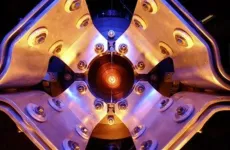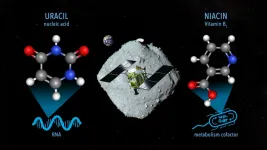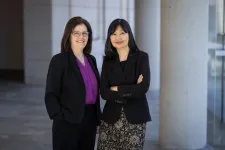(Press-News.org) Argonne received $3.5 million in funding to help accelerate battery production in America, lower costs, provide a domestic source of materials and reduce the environmental impact of electric vehicle batteries.
Batteries are critical to powering a clean energy economy. This is especially true in the transportation sector, where electric vehicles (EVs) are on track to make up half of all new vehicle sales by 2030. In order to meet this rapidly increasing demand, the U.S. Department of Energy (DOE) is distributing funding to advance domestic recycling and reuse of electric vehicle batteries. Managed by DOE’s Vehicle Technologies Office, these grants are part of a $7 billion investment to strengthen the domestic battery supply chain. Each of the grants will be matched with funding from the receiving company, potentially doubling their impact.
Electric vehicle batteries contain many valuable minerals and materials. The U.S currently does not produce enough of these minerals and materials to manufacture EV batteries without relying on imports. The demand for critical battery components, such as lithium and graphite, are projected to increase by as much as 4,000% in the coming decades. If this problem is not addressed, it could limit the development and adoption of clean energy battery technologies.
Battery recycling can address these issues by providing a domestic supply of battery materials. It also has the added benefit of reducing supply chain disruptions, reducing the environmental impact of EV battery production and encouraging the production of batteries made in the U.S.
“Argonne is excited to have this great opportunity to help advance battery recycling technology and support the effort to expand commercial-scale battery materials production and manufacturing in the U.S.” — Jeffrey Spangenberger, ReCell Center director and group leader in materials recycling at Argonne
DOE’s Argonne National Laboratory has emerged as a global leader in battery recycling. Scientists at Argonne have pioneered new ways to extract materials from old batteries so they can be recycled and used again. They also have developed state of the art models to evaluate the economic and environmental impacts of each stage of a battery’s life, from mining of the raw materials through recycling. Argonne has a successful track record of collaborating with industry and other national labs. This experience has led to the development of a number of partnerships between Argonne and the materials production or recycling industries. Partnerships include:
Faster, cleaner lithium extraction
Lilac Solutions has developed a new method to extract lithium from brines that can double the lithium recovery compared to conventional methods and dramatically reduce production time — all with a minimal impact on the environment. Argonne is helping Lilac better understand the potential of their new technology.
Building a plant to extract lithium from claystone
American Battery Technology Company (ABTC) is building a field demonstration facility that produces lithium hydroxide from claystone deposits. Their new technology can potentially reduce the costs and environmental impacts of lithium production. Argonne is helping ABTC conduct analyses of their technology, estimating production costs and environmental impacts and helping them identify opportunities for improvement.
Reducing costs and environmental impacts of lithium-ion battery recycling
ABTC is also working with Argonne on a separate project that will optimize and test new advanced separation and processing technologies at an ABTC battery recycling facility. The new technologies have the potential to work better and cost less, while using less water and having less of an environmental impact.
Linking battery recycling with mine waste reclamation
Michigan Technical University will be working with Argonne on a project that aims to address issues of the cost and quality of material produced in battery recycling by coupling the recycling with existing mine waste reclamation efforts. If successful, the project could reduce energy use by 25%. It could also help to establish a profitable U.S. battery recycling business and provide needed battery materials from unconventional sources.
Direct recycling of used lithium-ion batteries
Argonne scientists will also be working with Princeton NuEnergy Inc. to develop new direct recycling methods for end-of-life lithium-ion batteries. Today, most battery recycling involves breaking down existing batteries to extract the raw material needed for production. Direct recycling uses the battery components without breaking down the chemical structure. This approach significantly lowers costs and increases material performance. It also reduces chemical waste and limits the risk associated with the materials supply chain.
Scaling up a novel purification strategy for direct recycling of batteries
The University of California San Diego (UCSD) received funding to demonstrate a battery recycling technology that integrates a purification process into regeneration to improve the quality of cathode materials while reducing costs by up to 80%. Argonne scientists will help UCSD develop a working pilot, which could help solve the issue of limited domestic cathode supply.
These projects are just some of the ways Argonne is supporting industry to get advanced battery recycling technology to market.
“Argonne is excited to have this great opportunity to help advance battery recycling technology and support the effort to expand commercial-scale battery materials production and manufacturing in the U.S.,” said Jeffrey Spangenberger. Spangenberger leads the materials recycling group at Argonne. He also leads the ReCell Center, a national collaboration — headquartered at Argonne — of industry, academia and national laboratories working together to advance battery recycling technologies.
The first electric vehicles to hit the U.S. market are nearing the end of their life. Argonne is developing the technology needed to recycle their EV batteries and reclaim the precious metals they contain, so they can be used power the electric vehicles of the future. By 2040, nearly 8 million tons of EV batteries may be available for recycling. Tapping them for our metal needs can reduce emissions by as much as 16 million tons a year while also providing a much-needed domestic source for battery materials.
Funding for these projects comes from DOE’s Office of Energy Efficiency and Renewable Energy, Vehicle Technologies Office. Additional funding and support will be provided by the companies who are grant recipients.
Argonne National Laboratory seeks solutions to pressing national problems in science and technology. The nation’s first national laboratory, Argonne conducts leading-edge basic and applied scientific research in virtually every scientific discipline. Argonne researchers work closely with researchers from hundreds of companies, universities, and federal, state and municipal agencies to help them solve their specific problems, advance America’s scientific leadership and prepare the nation for a better future. With employees from more than 60 nations, Argonne is managed by UChicago Argonne, LLC for the U.S. Department of Energy’s Office of Science.
The U.S. Department of Energy’s Office of Science is the single largest supporter of basic research in the physical sciences in the United States and is working to address some of the most pressing challenges of our time. For more information, visit https://energy.gov/science.
END
Argonne is helping U.S. companies advance battery recycling technology and strengthen the nation’s battery supply chain
2023-03-21
ELSE PRESS RELEASES FROM THIS DATE:
Machine learning programs predict risk of death based on results from routine hospital tests
2023-03-21
If you’ve ever been admitted to hospital or visited an emergency department, you’ve likely had an electrocardiogram, or ECG, a standard test involving tiny electrodes taped to your chest that checks your heart’s rhythm and electrical activity.
Hospital ECGs are usually read by a doctor or nurse at your bedside, but now researchers are using artificial intelligence to glean even more information from those results to improve your care and the health-care system all at once.
In recently published findings, the research team built and trained machine learning programs based on 1.6 ...
Imaging the proton with neutrinos
2023-03-21
The Science
Protons and neutrons, the building blocks of atomic nuclei, are themselves made up of strongly interacting quarks and gluons">quarks and gluons. Because the interactions are so strong, the structure of protons and neutrons is difficult to calculate from theory. Instead, scientists must measure it experimentally. Neutrino experiments use targets that are nuclei made of many protons and neutrons bound together. This complicates interpreting those measurements to infer proton structure. ...
To ward off aging, stem cells must take out the trash
2023-03-21
In humanity’s ongoing quest for the elixir of life, the science keeps pointing to stem cells. Research increasingly shows that maintaining stem cell fitness promotes a long healthspan, and new findings show keeping stem cells clean and tidy is an integral step.
In a study published March 21, 2023 in Cell Stem Cell, researchers at University of California San Diego School of Medicine found that blood stem cells use an unexpected method to get rid of their misfolded proteins, and that this pathway’s ...
Uracil found in Ryugu samples
2023-03-21
Samples from the asteroid Ryugu collected by the Hayabusa2 mission contain nitrogenous organic compounds, including the nucleobase uracil, which is a part of RNA.
Researchers have analyzed samples of asteroid Ryugu collected by the Japanese Space Agency’s Hayabusa2 spacecraft and found uracil—one of the informational units that make up RNA, the molecules that contain the instructions for how to build and operate living organisms. Nicotinic acid, also known as Vitamin B3 or niacin, which is an important cofactor for metabolism in living organisms, was also detected in the same samples.
This discovery by an international team, led by Associate Professor ...
Honey, the 3D print--I mean, dessert--is ready!
2023-03-21
New York, NY—March 21, 2023—Cooking devices that incorporate three-dimensional (3D) printers, lasers, or other software-driven processes may soon replace conventional cooking appliances such as ovens, stovetops, and microwaves. But will people want to use a 3D printer--even one as beautifully designed as a high-end coffee maker--on their kitchen counters to calibrate the exact micro- and macro-nutrients they need to stay healthy? Will 3D food printing improve the ways we nourish ourselves? What sorts of ...
Albert Einstein College of Medicine and Montefiore Health System awarded $30 million from NIH to support its Institute for Clinical and Translational Research
2023-03-21
March 21, 2023—BRONX, NY—Albert Einstein College of Medicine and Montefiore Health System have received a seven-year, $30 million grant from the National Institutes of Health (NIH) to continue support for the Harold and Muriel Block Institute for Clinical and Translational Research at Einstein and Montefiore (ICTR). The latest Clinical and Translational Science Award (CTSA) will ensure the ICTR will further its vision to improve health in the Bronx, Westchester, and lower Hudson Valley by accelerating the translation of scientific discoveries into effective and equitable prevention and treatment approaches.
“Since establishing ...
Diet and exercise programs alone won’t tackle childhood obesity
2023-03-21
Focusing on immediate fixes such as diet and exercise programs alone won’t curb the tide of childhood obesity, according to a new study that for the first time maps the complex pathways that lead to obesity in childhood.
Coordinated by the University of Sydney’s Charles Perkins Centre the study finds children whose parents did not complete high school and who live with social disadvantage, were more likely to be affected by overweight or obesity in mid-adolescence. High school completion is a strong indicator of socio-economic status.
These factors were ‘on ramps’ which flow down to influence the body ...
New Yale study evaluates PAXLOVID’s use in Long COVID recovery
2023-03-21
New Haven, Conn. — Yale School of Medicine announces the initiation of a novel, randomized trial that will test whether receiving PAXLOVIDTM (nirmatrelvir tablets; ritonavir tablets) for 15 days can improve the health of highly symptomatic adults with Long COVID.
The trial, led by Yale School of Medicine Professors Harlan Krumholz and Akiko Iwasaki, has a decentralized design, meaning that participants do not have to travel to study sites. It also uses a novel, participant-centric, digital approach to data collection.
Long COVID, also known as post-acute sequelae SARS-CoV-2 ...
ESMT Berlin: New book on how industrial companies can survive deglobalization
2023-03-21
Deglobalization and the unpredictability of global business have led technology-based industries to review their overall strategies. Current geopolitical changes – the war in Ukraine, effects of the pandemic, and greenhouse gas emission targets – revived discussions about the value of globalization. However, international trade of goods and services has been slowing down significantly since 2011, with increasing nationalism being a factor. Additionally, lower salary differentials between developed and emerging economies have reduced overseas product shipments – which are increasingly criticized regarding environmental impact. So, how ...
Scientists find a common thread linking subatomic color glass condensate and massive black holes
2023-03-21
The Science
Physicists have discovered a remarkable correspondence between dense states of gluons—the gluelike carriers of the strong nuclear force within atomic nuclei—and enormous black holes in the cosmos. The dense walls of gluons, known as a color glass condensate (CGC), are generated in collisions of atomic nuclei. This CGC measures a mere 10-19 kilometers across—less than a billionth of a kilometer. Black holes, in contrast, span billions of kilometers across. The new work shows that both systems are made of densely packed, self-interacting force carrier particles. In CGC, those particles are ...





